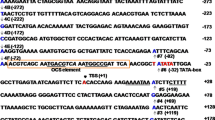Abstract
TNPA, one of the two transposition proteins encoded by the En/Spm transposable elements of Zea mays, suppresses the expression of genes that contain an appropriate cis element. Suppression can be monitored in tobacco protoplasts in a transient expression assay as follows. The plant promoter-driven expression of the Escherichia coli-glucuronidase (GUS)-encoding gene, uidA, is repressed in the presence of TNPA if the GUS gene contains a functional cis element in the untranslated RNA leader sequence. Earlier, we found that the minimal cis element is composed of two 12 by sequences in a tail-to-tail inverted orientation. Each 12 by sequence is sufficient to bind TNPA in vitro and can be thought of as a half-site in the cis element. Here, we investigated the sequence requirements of the minimal cis element. Our observations support our expectations that a functional cis element must provide a template to which two TNPA molecules can bind in the correct orientation. Sequences within the half-sites can be altered as long as the eight bases that make up the consensus binding sites are not changed. However, we found the following unexpected sequence specificities. Firstly, some changes to the consensus binding sequence can be tolerated in one half-site, as long as the other site matches the consensus. Secondly, although the region between the half-sites can vary in sequence and in length between two and four bases, a thymidine residue is not tolerated directly 5′ preceding the second half-site. Since many variants of the cis element sequence remain functional, the suppressor response element provides a flexible tool for artificially manipulating the expression of genes.
Similar content being viewed by others
References
Birnboim HC, Doly J (1979) A rapid alkaline extraction procedure for screening recombinant plasmid DNA. Nucleic Acids Res 7:1513–1523
Chuprina VP, Lipanov AA, Fedoroff OY, Kim S-G, Kintanar A, Reid BR (1991) Sequence effects on local DNA topology. Proc Natl Acad Sci USA 88:9087–9091
de Wet JR, Wood KV, Helinski DR, Deluca M (1985) Cloning of firefly luciferase cDNA and the expression of active luciferase in Escherichia coli. Proc Natl Acad Sci USA 82:7870–7873
de Wet JR, Wood KV, Deluca M, Helinski DR, Subramani S (1987) Firefly luciferase gene: Structure and expression in mammalian cells. Mol Cell Biol 7:725–737
Evans RM (1988) The steroid and thyroid hormone receptor superfamily. Science 240:889–895
Frey M, Reinecke J, Grant S, Saedler H, Gierl A (1990) Excision of the En/Spm transposable element of Zea mays requires two element-encoded proteins. EMBO J 9:4037–4044
Gierl A, Schwarz-Sommer Z, Saedler H (1985) Molecular interactions between the components of the En-1 transposable element system of Zea mays. EMBO J 4:579–583
Gierl A, Lütticke S, Saedler H (1988) TNPA product encoded by the transposable element En-1 of Zea mays is a DNA binding protein. EMBO J 7:4045–4053
Grant SR, Gierl A, Saedler H (1990) En/Spm encoded TNPA protein requires a specific target sequence for suppression. EMBO J 9:2029–2035
Harrison SC, Aggarwal AK (1990) DNA recognition by proteins with the helix-turn-helix motif. Annu Rev Biochem 59:933–969
Hein T, Prezewozny T, Scheider O (1983) Culture and selection of somatic hybrids using an auxotrophic cell line. Theor Appl Genet 64:119–122
Kim H-Y, Schiefelbein JW, Raboy R, Furtek DB, Nelson OE Jr (1987) RNA splicing permits expression of a maize gene with a defective Supressor-mutator transposable element insertion in an exon. Proc Natl Acad Sci USA 84:5863–5867
Jefferson RA, Kavanagh TA, Bevan MW (1987) GUS fusions: Beta-glucuronidase as a sensitive and versatile gene fusion marker in higher plants. EMBO J 6:3901–3907
Luisi BF, Xu WX, Otwinowski Z, Freedman LP, Yamamoto KR, Sigler PB (1991) Crystallographic analysis of the interaction of the glucocorticoid receptor with DNA. Nature 352:497–505
Mariani C, Gossele V, De Beuckeleer M, De Block M, Goldberg RB, De Greef W, Leemans J (1992) A chimaeric ribonuclease-inhibitor gene restores fertility to male sterile plants. Nature 357:384–387
McClintock B (1954) Mutations in Zea mays and chromosomal aberrations in Neurospora. Carnegie Inst Washington Year Book 53:254–260
Menssen A, Höhmann S, Martin W, Schable PS, Peterson PA, Saedler H, Gierl A (1990) The En/Spm transposable element of Zea mays contains splice sites at the termini generating a novel intron from a dSpm element in the A2 gene. EMBO J 9:3051–3057
Negrutiu I, Shillito R, Potrykus I, Biasini G, Sala F (1987) Hybrid genes in the analysis of transformation conditions. Plant Mol Biol 8:363–373
Nevers P, Shepherd N, Saedler H (1984) Plant transposable elements. Adv Bet Res 12:102–203
Pereira A, Cuypers H, Gierl A, Schwarz-Sommer Z, Saedler H (1986) Molecular analysis of the En/Spm transposable element system of Zea mays. EMBO J 5:835–841
Pröls M, Töpfer R, Schell J, Steinbiss H-H (1988) Transient gene expression in tobacco protoplasts: I. Time course of CAT appearance. Plant Cell Rep 7:221–224
Riggs CD, Chrispeels MJ (1987) Luciferase reporter gene cassettes for plant gene expression studies. Nucleic Acids Res 19:8115
Scheifelbein JW, Raboy V, Fedoroff N, Nelson OE Jr (1985) Deletions within a defective Suppressor-mutator element in maize affect the frequency and developmental timing of its excision from the bronze locus. Proc Natl Acad Sci USA 82:4783–4787
Schwarz-Sommer Z, Gierl A, Berndtgen R, Saedler H (1985) Sequence comparison of ‘states’ of a1-m1 suggest a model of Spm (En) action. EMBO J 4:2439–2443
Trentmann S, Saedler H, Gierl A (1993) The transposable element En/Spm encoded TNPA protein contains a DNA binding and a dimerisation domain. Mol Gen Genet 238: pp 201–208
Vieira J, Messing J (1982) The pUC plasmids, an M13 mp7-derived system for insertion mutagenesis and sequencing with synthetic universal primers. Gene 19:259–268
Author information
Authors and Affiliations
Additional information
Communicated by J. Schell
Rights and permissions
About this article
Cite this article
Grant, S.R., Hardenack, S., Trentmann, S. et al. Functional cis-element sequence requirements for suppression of gene expression by the TNPA protein of the Zea mays transposon En/Spm. Molec. Gen. Genet. 241, 153–160 (1993). https://doi.org/10.1007/BF00280212
Received:
Accepted:
Issue Date:
DOI: https://doi.org/10.1007/BF00280212




